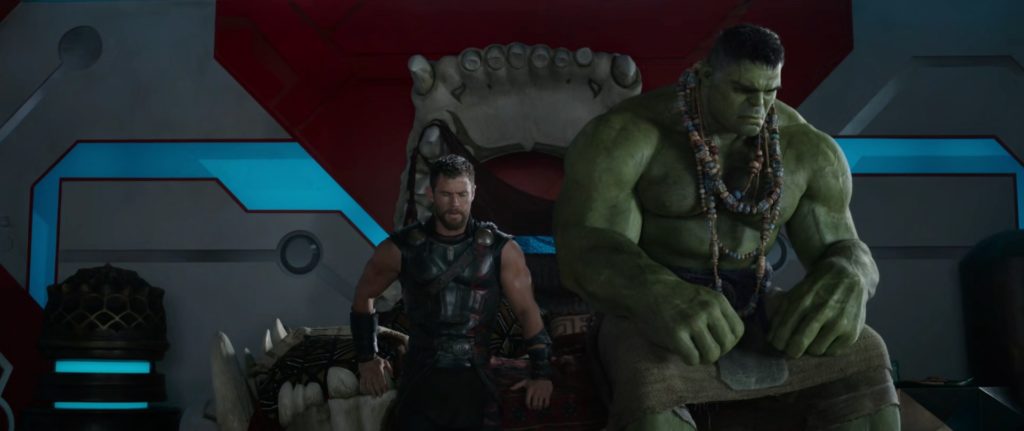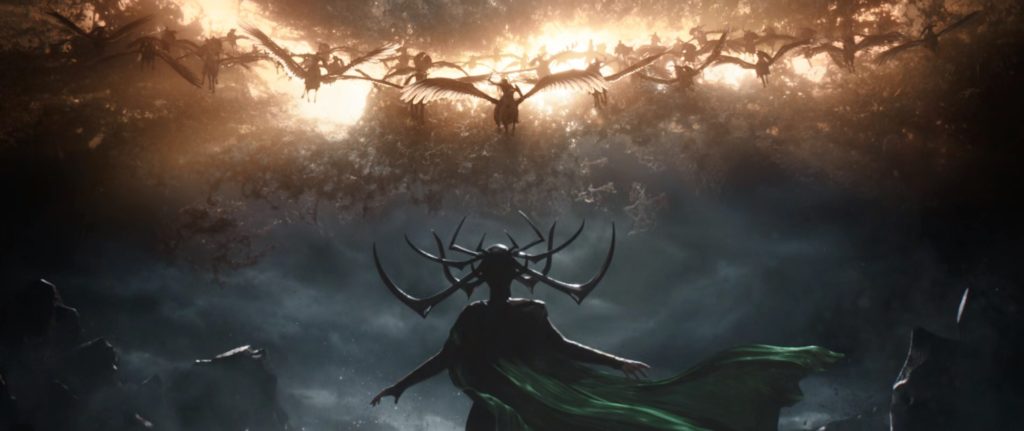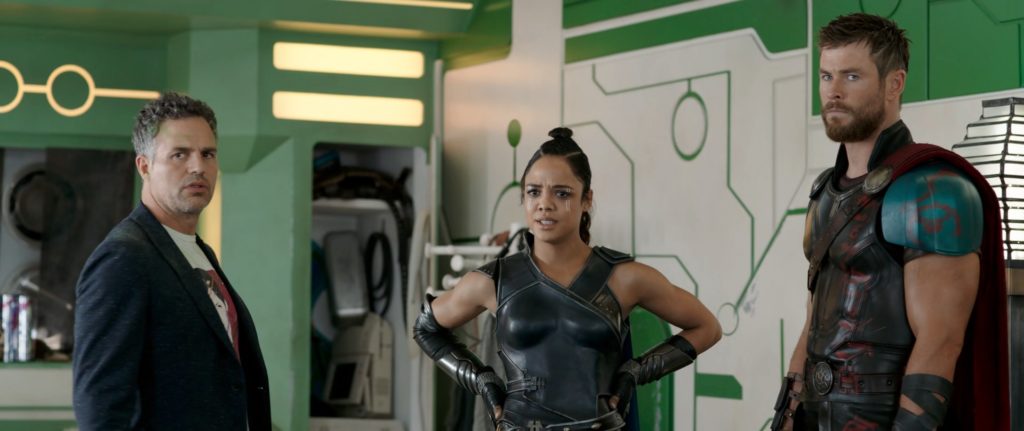In this weekly series, we chronicle the long road undertaken by the Marvel Cinematic Universe movies to arrive at Avengers: Infinity War. We introspect and discuss the movies from a critical and commercial standpoint while also considering the development efforts that went behind them. These articles may be occasionally sprinkled with spoilers so please make sure to skip the relevant sections when reading.
This post is about the 2017 movie Thor: Ragnarok, the seventeenth chapter in the Marvel Cinematic Universe. To check out other entries in our Road to Infinity War series, click here.
2017 marked an important milestone for Marvel Studios. It was the first year the production machine was able to release 3 films in a year. Coincidentally (or perhaps by virtue of great filmmaking), all three films turned out to be big-grossers at the box-office, making in excess of $850 million worldwide, and taking Marvel’s annual total beyond $2 billion. The final leg of their 2017 release schedule was the heavily marketed and promoted Thor: Ragnarok. Ever since the first teaser came out in April that year, set to Led Zeppelin’s Immigrant Song, the movie has stirred an unprecedented buzz among fans and critics alike who since developed out of the world expectations from this movie. The teaser conveyed a starkly different vibe from earlier MCU films, especially from earlier Thor installments, promising more color, jazz and cool surreal otherworldly visuals packed to the brim with imaginative scenery and world-building. The second trailer that came out during Comic Con promised something that everyone hoped from the movie ever since Taika Waititi was brought on board and handed over the directorial reins: humor. Viewers got a glimpse into what’s in store for a Thor movie in terms of witty one-liners and a complete re-imagining of the character Chris Hemsworth embodied and made rightfully his own.
In a movie titled Ragnarok and publicized as the “end of all things”, it’s extremely difficult to pull off humor in a satisfying manner. Striking a balance between letting the dramatic beats play out with sufficient grit and yet squeezing in a few jokes and quips is immensely hard and for the most part, Waititi succeeds in pulling it off. However, there are still places where the humor feels off and it couldn’t be more evident than in the concluding bits. Without giving anything away, characters joking at the expense of a tragic outcome takes away some impact of the tragedy, instead making it come across as a mechanical plot-point. I’m not even sure how else it could’ve been handled as the past few Thor movies have proven that seriousness may not necessarily lead to an outstanding movie, especially with The Dark World. Perhaps the first Thor had the right skew of heart v/s humor that I was looking for and this one steps up the humor quotient a notch or two higher than intended.
Regardless, what stands out about Ragnarok is how rich in visual narrative and deft the movie is, to the extent that it almost comes across as a worthy rival to James Gunn’s highly extravagant Guardians of the Galaxy. To get into that though, let’s briefly look at what the movie is about. After the events of Age of Ultron, Thor has been haunted by visions of the Infinity Stones and a prophecy called Ragnarok, heralding the imminent destruction of Asgard. In the two years since, Thor’s searched for the Infinity Stones to no avail and ends up captured by Surtur, The Fire Demon. Turns out Surtur is responsible for Ragnarok and Thor swiftly breaks out of captivity and takes him out in the film’s opening moments, carrying his crown to Asgard. Little does Thor realize that the real threat is actually his sister Hela, the Goddess of Death, who is freed from imprisonment after Odin perishes and becomes one with the universe. Hela invades Asgard and sends Thor and Loki crashing to an alien planet named Sakaar, ruled by a crazy Grandmaster (Jeff Goldblum, at his improvisational best). Thor must breakout of that planet and assemble his comrades to bring the fight back to Hela.
Thor’s team includes people we’re mostly familiar with, and then some new. First off is Hulk, who as it’s revealed, drove his Quinjet into outer space and ended up on Sakaar through one of the many Wormholes connecting to it. He’s been gladly participating in the Grandmaster’s gladiatorial games, squishing his opponents, and has quickly acquired a cult status as the Incredible Warrior on Sakaar with a statue to his name. Thor becomes a contender who has to fight Hulk without his hammer Mjolnir (destroyed earlier by Hela) and a new haircut (courtesy a Stan Lee cameo). The Hulk and Bruce Banner have always been at odds with each other as personalities and Ragnarok delves into that aspect heavily. Hulk is enjoying his newfound fame and has even developed a small kid’s vocabulary (still more than Groot’s) and there’s something to be said about how Hulk is so saddened and depressed about people hating him on earth that he refuses, and even fights from turning back to Banner. Banner for his part awakens after the events at Sokovia and has no idea what he’s been doing as the Hulk, almost like that part of his personality was asleep all this while. The gap between the two has been widening making every transformation increasingly more difficult. As for the gladiator match itself, the entire fight sequence is presented in a highly epic manner that truly gives a sense of the environment’s humongous scale, the impact of every punch landed by either Thor or Hulk registering hard. Thank God for oxygen on Sakaar, for Banner can breathe easy when he reverts back.
 Thor’s next team member happens to be a Valkyrie, played by the enigmatic, strong-minded and almost heroic Tessa Thompson. Valkyrior were tough warriors who fought Hela in earlier battles but lost. Tessa’s Valkyrie has since resigned to a drunken life on Sakaar, bringing in contenders for the Grandmaster and getting paid handsomely for it. She’s the one who brings Thor in. Thompson takes inspiration from strong female action characters of the past such as Linda Hamilton in the Terminator series and takes a ballsy approach to portraying her character, unafraid and undeterred by all the madness around her. Eventually, a glimpse of Hela’s invasion as a horrific nightmare convinces her to side with Thor and return to Asgard to fight Hela.
Thor’s next team member happens to be a Valkyrie, played by the enigmatic, strong-minded and almost heroic Tessa Thompson. Valkyrior were tough warriors who fought Hela in earlier battles but lost. Tessa’s Valkyrie has since resigned to a drunken life on Sakaar, bringing in contenders for the Grandmaster and getting paid handsomely for it. She’s the one who brings Thor in. Thompson takes inspiration from strong female action characters of the past such as Linda Hamilton in the Terminator series and takes a ballsy approach to portraying her character, unafraid and undeterred by all the madness around her. Eventually, a glimpse of Hela’s invasion as a horrific nightmare convinces her to side with Thor and return to Asgard to fight Hela.
The third member is unexpectedly, Thor’s adopted brother Loki. Continuing from Thor: The Dark World, there’s a hilarious sequence at the beginning which carries forward the twist from that movie’s end. With Odin’s absence, and with Loki masquerading as Odin, he has taken on to worshiping his own feats and beating his own trumpet, constructing a huge statue in his likeness and remembrance and even holding a humorous play featuring a mockingly twisted version of events from The Dark World that showed his presumed death. It’s also the scene that sees high-profile cameos by Liam Hemsworth (play Thor), Matt Damon (fake Loki) and Sam Neil (fake Odin) which I must embarrassingly admit I failed to spot the first time around (great disguises). Anthony Hopkins excellently plays a mischievous Loki going by his form and gets to experiment and goof around as Odin thanks to the well-written scene, and he seems to fully relish the opportunity. Anyhow, despite all that Loki’s done, Thor fights side-by-side with him at several moments in the movie, an odd choice but one that Thor certainly recognizes and is wary of this time, as he foils one of his brother’s countless attempts at betraying him. Oh Loki … Will thou ever learn?
Amid all the humor and witty one liners, there are some dramatic moments hidden in that do get to play out effectively. Two of these that immediately come to mind are a touching scene between Odin and his sons Thor and Loki wherein the father realizes his time has come and imparts some words of wisdom to his sons, expressing his love for them. The key word here is “sons”, plural, and Loki’s reaction on being acknowledged as one is heartwrenching to say the least. Another exchange that plays out briefly in an elevator between Thor and Loki where Thor reminisces of what he thought about Loki, only to sort of have resigned to who Loki truly is has an equally heartbreaking vibe to it. You get the sense that Thor so desperately wanted Loki to abandon his malice and return to Thor’s side but his repeated betrayals and trickery have shaken Thor’s faith from Loki entirely. In that moment at least, Loki seems to at least partly realize his folly and what could’ve been had he relented to fighting by Thor’s side as opposed to with him. Unfortunately, that moment is quickly broken by a humorous interplay on Thor wanting to do “Get Help” with Loki. While the gag itself is funny, it completely destroys the touching scene that played before it.
 Another problem with Ragnarok is that it seems to suffer from a generic power hungry antagonist. While Hela is undoubtedly a key figure in both the comics and the movie, she’s barely fleshed out beyond the brief history she offers about her past with Odin. She’s come to Asgard to claim what’s rightfully hers? The entire planet? So she intends to rule the planet by slaying everyone around her? Or she intends to use the Bifrost to invade other realms and bring every one of them to serve her? Her motivations are unclear but even so, we don’t really care, nor is an effort made to make us care. She’s an out-and-out full-blown antagonist and despite the promotional heresay, her logic doesn’t come across as clearly, if at all there’s any to it. Her power though seems to amplify on Asgard and that holds the key in defeating her.
Another problem with Ragnarok is that it seems to suffer from a generic power hungry antagonist. While Hela is undoubtedly a key figure in both the comics and the movie, she’s barely fleshed out beyond the brief history she offers about her past with Odin. She’s come to Asgard to claim what’s rightfully hers? The entire planet? So she intends to rule the planet by slaying everyone around her? Or she intends to use the Bifrost to invade other realms and bring every one of them to serve her? Her motivations are unclear but even so, we don’t really care, nor is an effort made to make us care. She’s an out-and-out full-blown antagonist and despite the promotional heresay, her logic doesn’t come across as clearly, if at all there’s any to it. Her power though seems to amplify on Asgard and that holds the key in defeating her.
What Ragnarok does right though, aside from the humor of course, is in the impact it has on the MCU going forward, especially in the context of Thor. This is the paragraph where I need to delve into spoilers so be warned. By the time the movie has ended, Thor has lost his father, his hammer Mjolnir, his long locks, his planet Asgard, his sister and finally his eye which he replaces with an eye-patch to resemble his father. Ragnarok essentially implies the end of all old things and the beginning of a cycle anew and we see that metaphorically and less subtly represented by the movie’s outcome. The old Odin has made way for a new Odin, one stronger than him but one who, like his predecessor, dons the same eyepatch, holds the same morals and will lead his people in a new place, like his father before. He has no hammer as he needs none, his powers come through thunder and lightning, an aspect that so seamlessly fits into the character’s legacy I’m surprised it wasn’t tapped or touched upon in his past four appearances. Asgard is no longer a place, but “a people”. And with everyone headed to Earth, it’s as much of a new beginning for the Asgardians as it is for Thor Odinson. Speaking of Loki then, this could also potentially signify a new beginning for him, assuming of course Hiddleston has anything more left to try out as that character. This transition from the old to the new along with the amount of chances it brings upon Thor is one of Waititi’s most significant contributions to the ongoing MCU lore in my opinion.
The other thing Ragnarok has going for it is of course the humor. There’s a zaniness to it, not evident in any of the previous Thor installments, that comes in due to the presence of larger than life situations and characters. One of the more hilarious bits of the movie comes from a Kronan named Korg, a character made entirely out of rocks but quite contrary to his image, has a soft spoken demeanor. The character is voiced by Taika Waititi and has a hilarious backstory in which he got captured because not enough people turned up for a revolution he planned due to lack of pamphlets. He is accompanied by a larva-like creature Meek and provides some of the more comedic moments in the movie, his chemistry with Hemsworth in the Sakaar sequences being a treat to watch. The other crazy character is the Grandmaster who comes across as a connoisseur of all things sadistic pleasure, whether it’s food, orgies or watching people fight and destroy each other. He liquefies a failed contender in front of Thor with a generally calm demeanor, then expresses disgust at the melted down form. His monologues are mostly all improvised and the amount of cuts his speeches endure means he probably gave the filmmakers way too much material to play around with.
Ragnarok is a visual treat and a rich splendor and treasure of imagination. In the 2 hours excluding the credits that the movie runs for, you revisit Asgard and are introduced to Sakaar, the rich, vast, junkyard of a planet with the Grandmaster’s building standing tall at the center of it. We almost become privy to the civilization of Sakaar, the madness that constantly surrounds the place, and how densely packed it all is. Whether it’s the Gladiatorial Match, Hela’s fight at Asgard, the Valkyrie flashback, or the concluding bridge battle, it all screams vibrant colors, and a heavy visual deft unseen in movies of this caliber despite the huge budget. Kudos to cinematographer Javier Aguirresarobe, Production Designer Dan Hennah and Costume Designer Mayes Rubeo for all their work in bringing these new places and set pieces to life. Mark Mothersbaugh score evokes the previous themes of Thor to give this one a more cohesive feel as being part of the Thor universe while the use of Led Zeppelin’s Immigrant Song at two of the pivotal action scenes that bookend the movie serve as crowd-pleasing moments for an audience watching in a theater.
 Despite being four movies in playing the character, Hemsworth still takes it to a new place. Teaming up with Taika Waititi (who himself played the hilarious Korg), the duo uncover new aspects to Thor’s personality, especially his penchant for sarcastic, innocent humor that he seems to have picked up staying too long with humans and build on it, adding more to the character while yet stripping it off its essentials and old baggage. Hemsworth’s comic timing then helps hold the film together. Tom Hiddleston too tries one-upping Loki’s game but at this point, so many aspects of his personality have been tapped into that it’s hard to take Loki to a new place. Still, he tries and mostly succeeds. Cate Blanchett is menacing as Hela as Jeff Goldblum is unpredictable with the Grandmaster, even though the role itself is thinly written. Tessa Thompson leaves a strong impact as Valkyrie and by the time the movie has ended, you’ll probably soon forget that Jane Foster and Lady Sif weren’t in the movie at all. Idris Elba and Karl Urban get to play small parts as Heimdall and Skurge, the Executioner respectively but they both leave a strong impression. Urban bounces around most of the movie with repentance and a heavy conscience that comes with supporting Hela, until he predictably gives in to his good side. Finally, Ruffalo’s presence adds a whole new buddy-cop dynamic to the Thor franchise and he totally nails the mild-mannered scientist role to a T. Quite surprisingly, even the Hulk has much more of a stronger personality this time around that just smashing objects; he talks, he feels remorse and guilt and sad over the events of earth and people’s rejection of him. Finally, this would be incomplete without mention by a crowd-pleasing but equally amazing cameo by Benedict Cumberbatch as Doctor Stephen Strange, in an extension of the sequence that we saw mid-credits during the Sorcerer Supreme’s solo outing. And it appears all this while, Strange has learned some new tricks and become effortless at conjuring portals and shifting characters jarringly in a spotless manner. We’ll see how much of that plays out in his future appearances.
Despite being four movies in playing the character, Hemsworth still takes it to a new place. Teaming up with Taika Waititi (who himself played the hilarious Korg), the duo uncover new aspects to Thor’s personality, especially his penchant for sarcastic, innocent humor that he seems to have picked up staying too long with humans and build on it, adding more to the character while yet stripping it off its essentials and old baggage. Hemsworth’s comic timing then helps hold the film together. Tom Hiddleston too tries one-upping Loki’s game but at this point, so many aspects of his personality have been tapped into that it’s hard to take Loki to a new place. Still, he tries and mostly succeeds. Cate Blanchett is menacing as Hela as Jeff Goldblum is unpredictable with the Grandmaster, even though the role itself is thinly written. Tessa Thompson leaves a strong impact as Valkyrie and by the time the movie has ended, you’ll probably soon forget that Jane Foster and Lady Sif weren’t in the movie at all. Idris Elba and Karl Urban get to play small parts as Heimdall and Skurge, the Executioner respectively but they both leave a strong impression. Urban bounces around most of the movie with repentance and a heavy conscience that comes with supporting Hela, until he predictably gives in to his good side. Finally, Ruffalo’s presence adds a whole new buddy-cop dynamic to the Thor franchise and he totally nails the mild-mannered scientist role to a T. Quite surprisingly, even the Hulk has much more of a stronger personality this time around that just smashing objects; he talks, he feels remorse and guilt and sad over the events of earth and people’s rejection of him. Finally, this would be incomplete without mention by a crowd-pleasing but equally amazing cameo by Benedict Cumberbatch as Doctor Stephen Strange, in an extension of the sequence that we saw mid-credits during the Sorcerer Supreme’s solo outing. And it appears all this while, Strange has learned some new tricks and become effortless at conjuring portals and shifting characters jarringly in a spotless manner. We’ll see how much of that plays out in his future appearances.
No wonder then that, with all the elements in place for a ripe summer blockbuster, Thor: Ragnarok killed it as far as box-office goes. Sure it didn’t outdo its predecessor by a 2 to 1 but it reignited interest in the franchise which was largely considered by many to be the weakest of the trio (Iron Man, Captain America and Thor). The result was $315 million in the US and $854 million worldwide, highly positive reviews with decent scores and enough acclaim for Waiti and Hemsworth to leave the option of a fourth film on the table. Before that of course, there’s the ramifications of that mid-credit scene to deal with. As if Thor’s ship wasn’t large enough to hold what’s left of Asgard and its population (and somehow almost the entirety of Asgard’s population is capable of fitting on a ship; oh, the riches they enjoy), a ship that’s at least 5 times larger shows upfront overlooking Thor and Loki. That ship is the Sanctuary II and Thanos is on that ship. The Mad Titan has arrived to claim his Infinity Stone, the frightening implications of which will be explored in Avengers: Infinity War.
At the beginning of this post, we mentioned how 2017 was a great year for Marvel Studios. Well, 2018 only proves how much of an understatement that was when the MCU’s first black standalone superhero movie hit the ground running.





